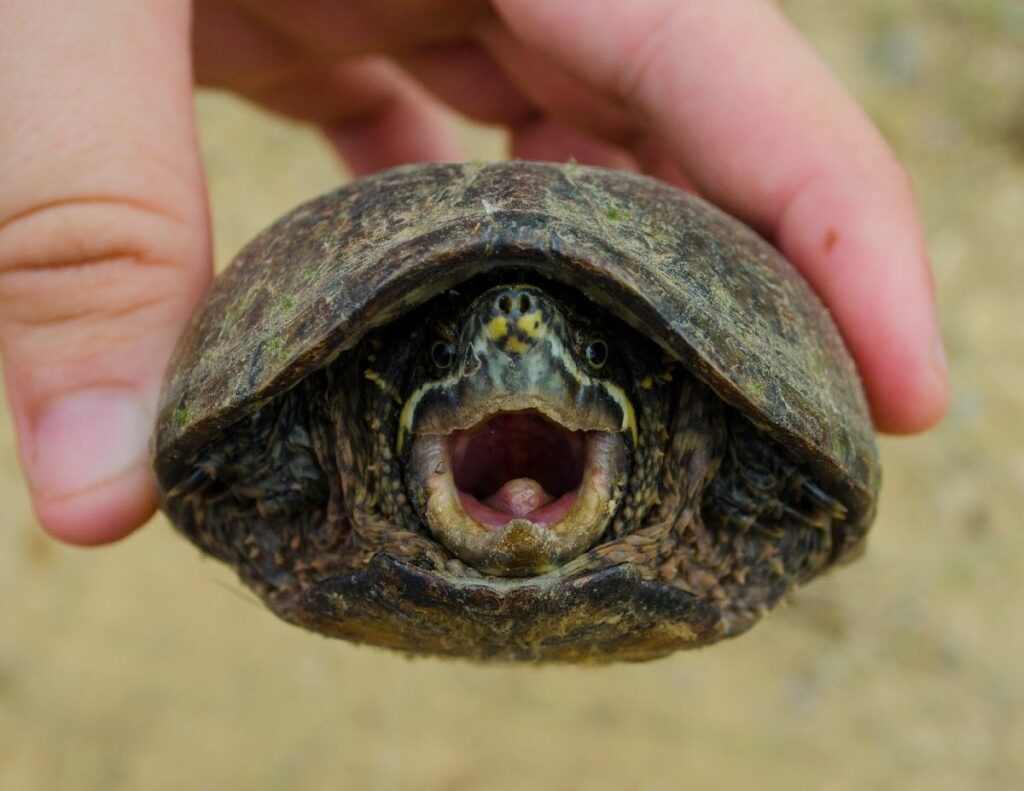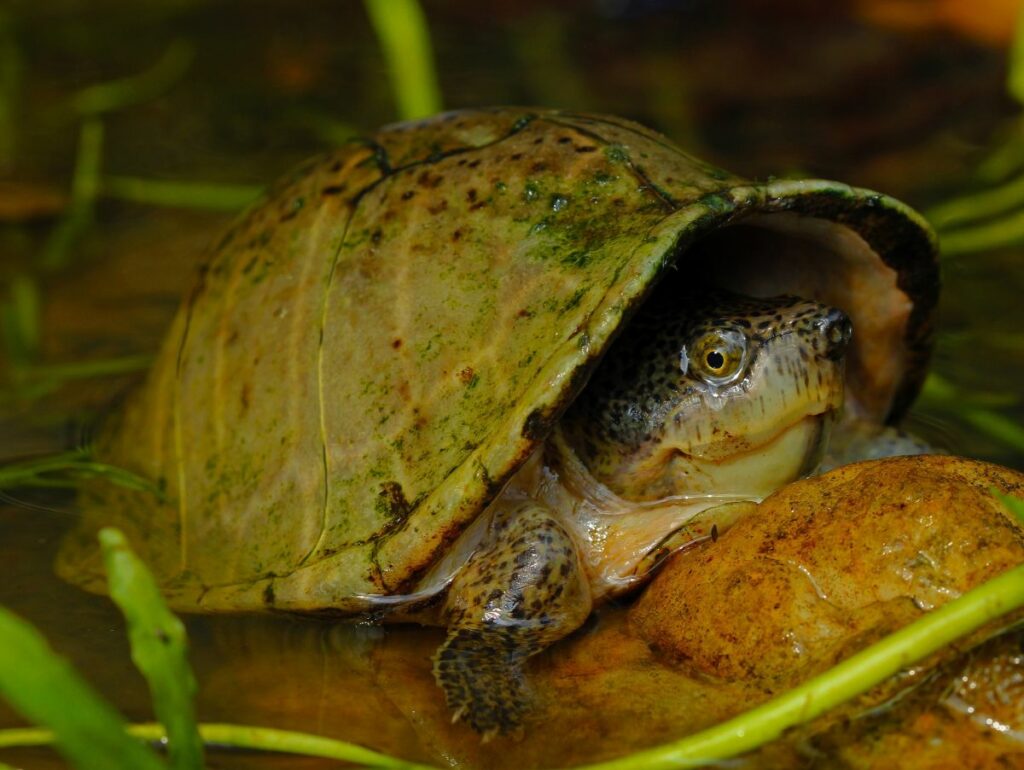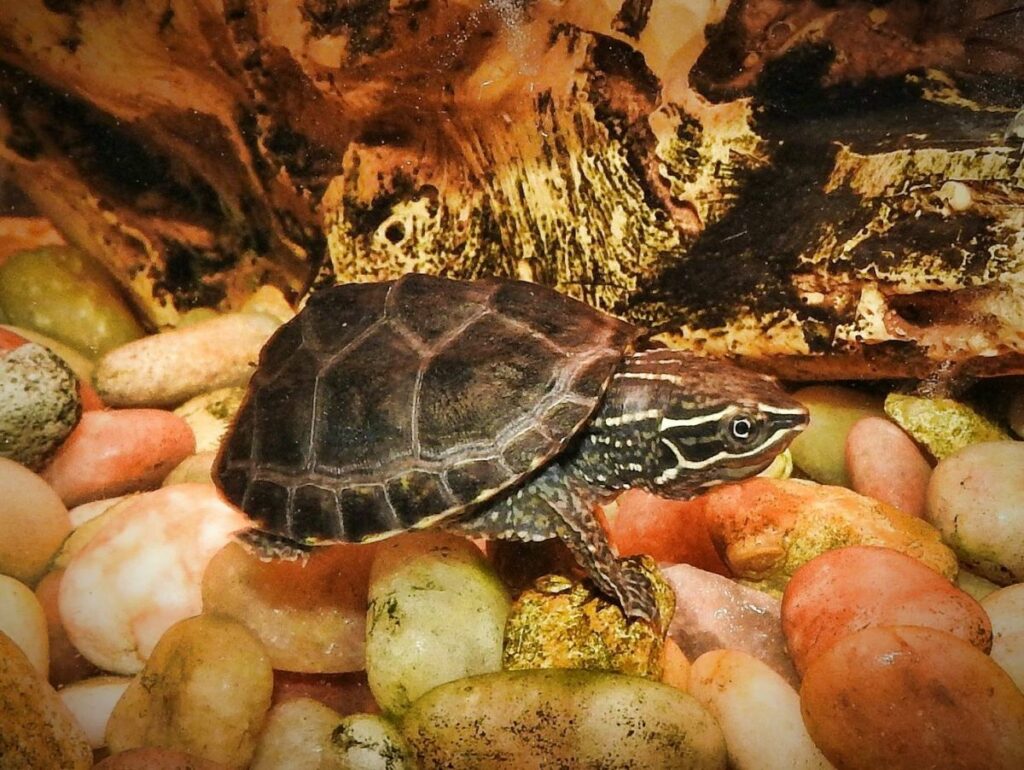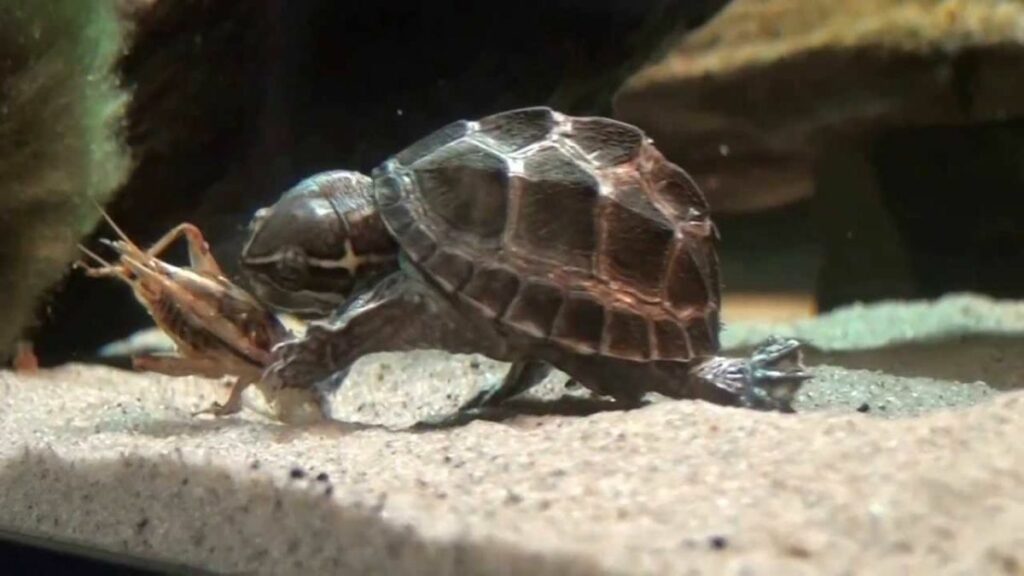Musk Turtle. Stinkpot. Mud Turtle. All of these names might put you off from trying Sternotherus odoratus. Which would be unfortunate because these are one of the best turtles for beginners to try.

Small and omnivorous, Musk Turtles are very hardy and long lived for such a small pet. So long as you accept that they don’t ever enjoy being handled, you and your Musk Turtle will get along just fine.
What is the Musk Turtle?
The Common or Eastern Musk Turtle is a popular aquatic turtle pet species. Musk Turtles get their name from one of their defensive mechanisms. If stressed or attacked they will release a cloudy liquid from scent glands at the edge of their shells.
The odor is hard to describe but is universal in its pungent, unpleasant character. Dogs and other animals with a sensitive sense of smell will drop a Musk Turtle rather than press the attack.
That said, Musk Turtles don’t stink all of the time. So you don’t have to worry about your turtle room smelling bad all of the time. Like most aquatic turtles they don’t enjoy being handled, however. You might get “musked” every time you have to pick one up.
Musk Turtles are quite easy to care for. They are also one of the smallest turtle pets you can find. Which makes setting up a turtle tank a lot easier compared to larger species like Red Eared Sliders or Box Turtles.
As natives to North America, Common Musk Turtles are found in the eastern part of the continent, from Canada to South Florida. Even though they are poor swimmers, Musk Turtles spend most of their time in the water.
Rather than paddling through it with speed these turtles will walk or run along the bottom. Musk Turtles prefer basking spots surrounded by water, like rocks or logs poking out of ponds. They only return to proper land in order to lay their eggs or move to a new habitat.
In fact, a Musk Turtle will become dehydrated if left out of the water for too long. That said, they still need a dry patch of land or a large rock/driftwood chunk as a basking spot.
Common Names: Common Musk Turtle, Eastern Musk Turtle, Stinkpot
Scientific Name: Sternotherus odoratus
Origin: Eastern North America
Length: 3 to 6 inches
Tank Size: 30 to 55 gallons
Musk Turtle Lifespan: 30 to 50 years
Ease of Care: Easy
Other Species of Musk Turtles
There are a few species of Musk Turtle native to North America. The Razorback Musk Turtle (Sternotherus carinatus) sometimes finds its way into pet stores as well.

Mud Turtles (Kinosternon sp.) are close relatives that also live in Mexico and South America. And like Musk Turtles, they will also release a defensive stink if they feel threatened.
Eastern Musk Turtle Care
Beginners might be intimidated by their stinky reputation. But the Common Musk Turtle is one of the best aquatic turtles to start out with. Their size is manageable, they are very hardy, and will eat anything you offer.
Musk Turtle Tank Size
You can keep a single Musk Turtle in an aquarium as small as 30 to 55 gallons. Musk Turtles can also live together so long as they are male and female. Two male turtles may end up fighting, however.
How Big Do Musk Turtles Get?
As one of the smallest common turtle pet species the Musk Turtle is a good choice for beginners. A full grown Eastern Musk Turtle will be around 5 to 6 inches long. Sometimes they stay a few inches shorter than this.
Musk Turtle Male or Female?
Since all Musk Turtles are small they don’t have as much sexual size dimorphism as other turtle species. Some turtle males can be only ½ the size of an adult female. But Musk Turtles can be somewhat similar in size.
The best way to tell the difference between male and female Stinkpot turtles is to examine the tail. A male Musk Turtle will have a longer, thicker tail with a ridge of spikes running along the top of it. Females have a short, squat tail with no spikes.
Setting Up a Musk Turtle Habitat
Since aquatic turtles spend most of their time underwater a Musk Turtle habitat does not need to be complicated. All that’s needed is a warm place to bask and clean water to swim in.

Lighting for Common Musk Turtles
The most important element to being successful with Eastern Musk Turtle care is choosing up the right lights. All aquatic turtles need more than visible light to survive. They also need ultraviolet radiation (UVb) and infrared radiation (heat).
An ultraviolet bulb allows a Musk Turtle to synthesize Vitamin D3 with their skin exposure. We humans also do this – but we can also get it through dietary supplements. Some turtle foods also have Vitamin D3 supplements.
But no scientific studies have been done to determine whether they absorb the vitamin when eaten or not. So for now, using UVb bulbs is the best way to ensure your Musk Turtle is getting the Vitamin D3 it needs.
The basking zone should also have a heat bulb of the right size and output. The air temperature should stay at around 90°F. Use a second thermometer to check how hot the actual basking surface is, as well. Temperatures beyond 96°F may scorch the sensitive belly of a Musk Turtle.
Water Conditions for Eastern Musk Turtle
Warm and well-filtered tank water is also important when caring for a Musk Turtle. These aquatic turtles prefer a water temperature of 80°F. Which means you will need a turtle tank heater.
Any heater (or filter) that is submerged should have a plastic mesh guard protecting it as well. Musk Turtles can crack the glass housing of a heater when diving into the water. A cracked heater will leak electricity if water gets inside, which will hurt or kill a swimming turtle.
What Do Musk Turtles Eat?
Like most aquatic turtles the Common Musk Turtle is an omnivore that will eat anything it catches. They tend to be more carnivorous, eating small aquatic animals like insects and snails. But they also supplement their diet with bites of aquatic vegetation.

Variety is important to a Musk Turtle diet because turtles are prone to vitamin deficiencies. For animal prey you can offer pet store live prey like mealworms and hissing roaches. The occasional thawed pinkie mouse or piece of fresh seafood will add further dietary richness. Wild bugs from your garden like grasshoppers, caterpillars, spiders, snails, and slugs are nice treats as well.
For vegetables the base of their salad should be leafy greens like spinach, romaine lettuce, or chard. Soft vegetables and fruit like apples, zucchini, melon, or strawberries are ideal. Just remember to remove the skin as Musk Turtles are small and will have a hard time biting through them.
Commercial turtle pellets or sticks are a great foundation for their diet as well. Many blends are enriched with Vitamin D3 and calcium, ensuring proper immune system and shell health. If you prefer, you may decide to stick to fresh ingredients and use a vitamin powder instead.
Full grown Musk Turtles should be fed two to three times per week as much as they will eat in around 6 minutes. Baby Eastern Musk Turtles should be fed daily as they are still growing and need the extra nutrition.
Conclusion
Musk Turtles will eat anything fresh and have a lifespan of up to 50 years. They don’t grow longer than 6 inches and will thrive in smaller turtle tanks than most species. You can even keep multiple Musk Turtles together with ease. In my view, few turtle species are so beginner-friendly.
More Frequently Asked Questions About Musk Turtles
Musk Turtle care is uncomplicated. But they aren’t as common to find in pet stores as sliders and other common species. Since I get questions about these turtles frequently here are a few that might be relevant to you.
Musk Turtles spend most of their time in the water but they are not good swimmers. They tend to walk or paddle along the bottom. So getting in and out of the water area of a Musk Turtle tank should be made as easy as possible using a ramp.
Musk Turtles can be kept in the company of each other or even Mud Turtles. It is best not to mix turtle species, however. Sometimes they become aggressive and territorial towards unrelated types of aquatic turtles. Musk Turtles are also small and easily bullied by larger turtles. All aquatic turtles are opportunistic predators and will try eating fish, frogs, and other tank mates.
If your local pet store has a dedicated section for reptiles you should ask if they will import baby Eastern Musk Turtles. Baby turtles will cost anywhere from $50-100. A baby Razorback Musk Turtle will often cost a little more than that, however.

